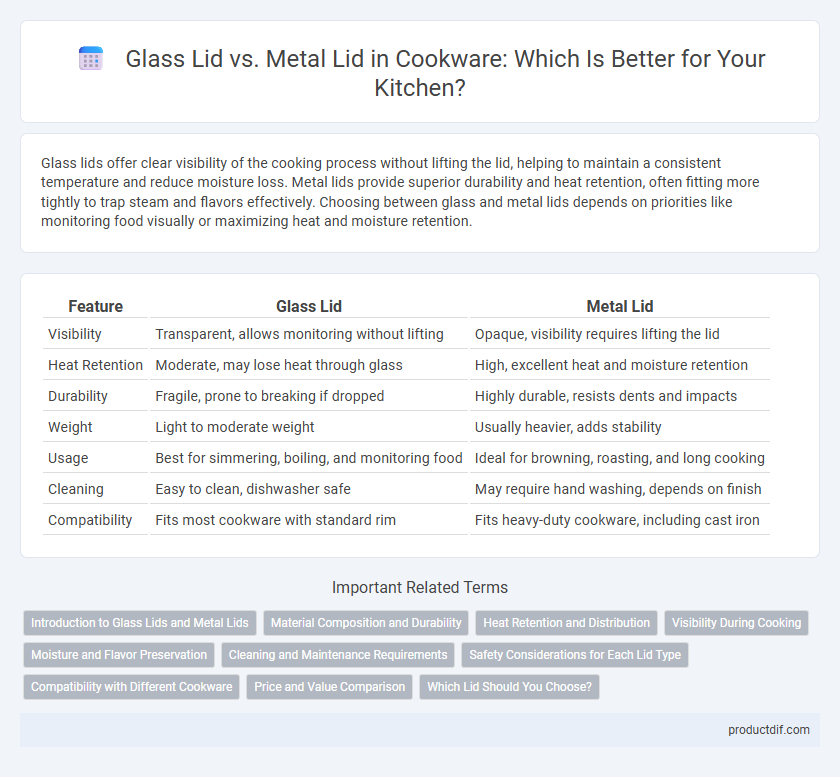Glass lids offer clear visibility of the cooking process without lifting the lid, helping to maintain a consistent temperature and reduce moisture loss. Metal lids provide superior durability and heat retention, often fitting more tightly to trap steam and flavors effectively. Choosing between glass and metal lids depends on priorities like monitoring food visually or maximizing heat and moisture retention.
Table of Comparison
| Feature | Glass Lid | Metal Lid |
|---|---|---|
| Visibility | Transparent, allows monitoring without lifting | Opaque, visibility requires lifting the lid |
| Heat Retention | Moderate, may lose heat through glass | High, excellent heat and moisture retention |
| Durability | Fragile, prone to breaking if dropped | Highly durable, resists dents and impacts |
| Weight | Light to moderate weight | Usually heavier, adds stability |
| Usage | Best for simmering, boiling, and monitoring food | Ideal for browning, roasting, and long cooking |
| Cleaning | Easy to clean, dishwasher safe | May require hand washing, depends on finish |
| Compatibility | Fits most cookware with standard rim | Fits heavy-duty cookware, including cast iron |
Introduction to Glass Lids and Metal Lids
Glass lids provide clear visibility of cooking progress without lifting the lid, helping to retain heat and moisture efficiently. Metal lids generally offer superior durability and heat retention, making them ideal for high-temperature cooking methods. Choosing between glass and metal lids depends on the need for monitoring food and the cooking style used.
Material Composition and Durability
Glass lids are typically made from tempered borosilicate glass, offering excellent heat resistance and the benefit of visual monitoring during cooking without lifting the lid. Metal lids, often crafted from stainless steel or aluminum, provide superior durability and better heat retention, ideal for high-heat cooking and long-term usage. While glass lids may chip or crack under extreme conditions, metal lids withstand heavy impacts and resist warping, making them more suitable for rugged kitchen environments.
Heat Retention and Distribution
Glass lids allow visual monitoring of cooking progress without heat loss, promoting consistent temperature control, but may have lower heat retention compared to metal lids. Metal lids excel in heat retention and distribution, creating an even cooking environment by trapping heat more effectively, which is ideal for slow cooking and simmering. Selecting between glass and metal lids depends on the need for visibility versus optimal heat management in cookware performance.
Visibility During Cooking
Glass lids offer superior visibility during cooking, allowing you to monitor food without lifting the lid and losing heat or moisture. Metal lids, while more durable and often better at retaining heat, obscure the contents, making it necessary to remove the lid for inspection. Choosing glass lids enhances precision in cooking by providing clear, immediate visual feedback.
Moisture and Flavor Preservation
Glass lids allow easy monitoring of cooking without releasing steam, effectively retaining moisture and preserving the natural flavors of food. Metal lids offer a tighter seal that traps steam more efficiently, enhancing moisture retention and intensifying flavors during cooking. Choosing between glass and metal lids impacts how well moisture and aroma are maintained, influencing the final taste and texture of dishes.
Cleaning and Maintenance Requirements
Glass lids offer easy visibility during cooking and are generally dishwasher safe, making cleaning straightforward and convenient. Metal lids, often more durable and resistant to warping, may require hand washing to preserve their finish and prevent rusting. Choosing between glass and metal lids depends on balancing visibility preferences with cleaning habits and maintenance needs.
Safety Considerations for Each Lid Type
Glass lids provide clear visibility during cooking, reducing the need to lift the lid and minimize heat loss, but they can shatter under sudden temperature changes or heavy impact. Metal lids offer superior durability and resistance to high heat, though they obscure food visibility and require caution to avoid burns from hot surfaces. Choosing between glass and metal lids involves balancing transparency for monitoring with the robustness needed for safety in high-temperature cooking environments.
Compatibility with Different Cookware
Glass lids provide clear visibility during cooking, compatible with various cookware materials like stainless steel, aluminum, and non-stick pans, while offering a tight seal to retain heat and moisture. Metal lids, typically made of stainless steel or aluminum, ensure durability and excellent heat conduction, complementing heavy-duty cookware such as cast iron and hard-anodized pots. Both lid types offer compatibility advantages, with glass lids favoring visual monitoring and metal lids excelling in heat distribution and robustness.
Price and Value Comparison
Glass lids typically cost more than metal lids but offer the clear advantage of visibility, allowing cooks to monitor food without lifting the cover and losing heat. Metal lids are often more affordable, durable, and better at retaining heat, providing excellent value for high-heat cooking and longevity. Choosing between glass and metal lids depends on balancing upfront cost with the benefits of visibility versus heat retention and durability.
Which Lid Should You Choose?
Glass lids offer the advantage of visibility, allowing you to monitor cooking progress without lifting the lid and losing heat, making them ideal for simmering and delicate dishes. Metal lids provide superior heat retention and durability, perfect for high-heat cooking and long braises where moisture retention is essential. Choose glass lids for tasks requiring visual control, while metal lids suit robust cooking techniques demanding even heat distribution.
Glass Lid vs Metal Lid Infographic

 productdif.com
productdif.com